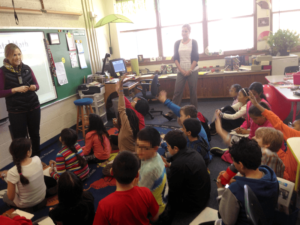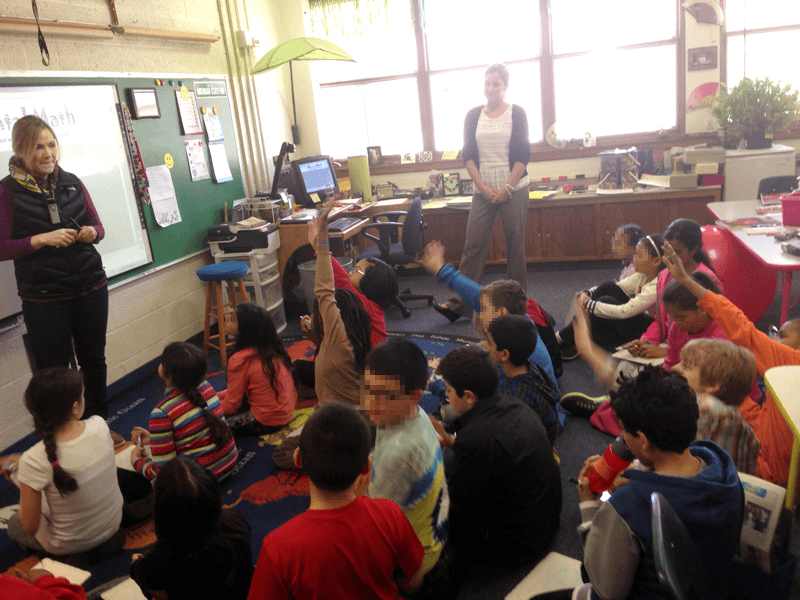Dave and I made the two-mile trek from the Michigan Virtual office up to Red Cedar Elementary to meet up with Mary Wever (@WeverWorld) and her student teacher Deedee Stasiak (@MissStasiak). We’re always eager to get out to schools to visit with teachers who are doing great things with blended learning. Mary and Deedee really fit that bill.
Our experience …
We appreciated Mrs. Wever and Miss Stasiak’s invitation to visit their class!
We met Mary and Deedee at a Flipped Classroom Seminar, put on by Terri Gustafson (@TGustafson) and the Center for Teaching & Technology at Michigan State. Dave and I were really impressed with how the teachers depicted their particular model of flipped instruction for 4th grade math. We took Mrs. Wever up on her invitation to join her students as they learned about fractions and probability. As the students came in the door from lunch/recess at 12:15, they sat down and interacted with their Everyday Mathematics workbooks as a transition exercise. Mrs. Wever told us later of the intentionality of this activity:
“They worked on their Math Box for the day … [They] are a mixture of previously learned concepts, current, and things to come in the future. There are six boxes with various problems (the program is spiraled, so there is a huge mixture), and I give them two minutes per box. I want to build their fluency and confidence while I assess their understanding too. They usually correct them with a partner when they finish so they can go over misconceptions and reteach each other, but I just had them continue with the boxes if they finished yesterday.”
During this time, I became aware that there were quite a few adults in the room. In addition to Mary and Deedee, three paraprofessionals join the class during math. Representing nationalities from around the world, Red Cedar is a culturally and socioeconomically diverse school. To serve their truly international population, one paraprofessional focuses on providing English Language Learning (ELL) support to students who are non-native English speakers. In addition, Title I funds have been allocated to allow for the other two paraprofessionals to provide targeted support.

Mrs. Wever and Miss Stasiak engaging students in guided practice. This formative assessment aides teachers and students in checking for understanding.
This teaching team constantly cycles the room offering general assistance and a lot of targeted support. Mary is constantly jotting on post-it notes as she keeps a pulse on student performance and needs. She shared with me some of these observations, ranging from specific content objectives that specific students are struggling with to students who will be needing extension activities soon. She uses these to plan interventions with certain students with her team ahead of time so that everyone is on the same page about the needs of each student and what will be done each day to meet those needs. But Mary makes it clear that she is not the only decision maker in this area:
“The paras proactively teach skills too. For instance, many students did not know their math facts at the beginning of the year. They can’t do much in 4th grade math if they don’t know their basic facts. So, those kids were put into differentiated groups (0%-50% on facts test in one group and 50%-85% in another) that were pulled from the first 10 minutes of school by two different paras (while I did attendance, etc.) to just work on learning multiplication/division facts. Once they tested 85% or better on the six-minute fluency test, they were no longer pulled. Now that they have their facts memorized and automatic, they can learn things like fractions with more ease.”
After engaging with their Math Boxes for the first portion of math, the students grabbed individual dry erase boards and huddled around Mrs. Wever. Here, she assisted them in guided practice exercises. Students would formulate equations that equated to them the fractions that she put on the interactive whiteboard. The individual whiteboards serve as a great formative assessment platform as students test their knowledge of concepts and hold it high above their heads to receive feedback from the teachers. This session was so quick, lasting less than 10 minutes, yet it allowed the teachers to check for understanding with every single student.
Deedee then asked students to recall the videos that they watched the night before. She asked students to self-assess their understanding of the content in the video in addition to their comfort level with the skills they displayed during guided practice. Based on this self-assessment, students put themselves into differentiated groupings described by Deedee that broke down like this:
Group |
Description |
|
“I can teach it” |
Students in this group watched the video(s) and understand the content. | |
“I understand it” |
Students in this group watched the video(s), with reasonable confidence but feel they could use more practice. | |
“I need your help” |
Student watched the video(s), but are in need of additional support in order to wrap their head around the concepts. | |
“I didn’t watch the video(s)” |
I need to watch them in class before joining one of the other groups. |
The “teach it” and “understand it” groups work together on activities that extend and expand upon the concepts that they are confident with.
Students in the “teach it” and “understand it” groups went back to their seats and worked on some independent practice exercises in their Everyday Mathematics workbooks, collaboratively teaching and learning from one another. The “need help” group received 1:1 support from one of the teachers to resolve confusion and work on learning the concepts in a personalized way. While this was going on the “didn’t watch” group shared a tablet, accessed the class website, and watched the videos in class. Four students, in whole, made up the “need help” and “didn’t watch” groups. Once they felt comfortable with the concepts, they transitioned to independent practice as well.
The community that has been established is outstanding. Most of the students assess their progress honestly and choose the group that meets their needs. There was no sense of unfairness or judgment cast upon anyone, which eliminated any fear of asking for help or to watch the videos in class. In fact, this learning environment explicitly encouraged students to seek help in pursuit of learning goals. Mrs. Wever explained to us how this community functions on a regular basis:
“Believe it or not, we actually have more issues with kids who want to stay at the carpet to get extra help/attention than we do with kids who try to go back to their seats to work on their own when they really don’t get it. I would have totally thought it would be the opposite! When we started, I was worried that kids would pretend like they got it so they could just go back to do the work. I was on the lookout for this and had eyes like a hawk. However, this never ended up being an issue at all. The kids in our class want to get more help if they think they need it (plus, there was a large amount of Title I math kids who are more dependent learners). I don’t know if you noticed, but there were two girls I sent to their seats to try the work before they could come to the carpet. And they ended up doing just fine.”
Utilizing two environments …
Mary utilizes the flipped classroom model extensively to inform her blended learning choices. When you visit the Wever World website that Mary and Deedee have built as a customized online environment, you’ll notice that each math unit’s concepts are illustrated by way of the Math Help section. Here you will find videos that the teachers have created and curated to act as direct instructional resources. These videos are never longer than four minutes and each are isolated to a single concept. Students that understand the concepts really well are encouraged to create their own how-to videos, an empowering extension activity for those students approaching mastery. Mary adds that,
“It encourages students to use correct vocabulary to explain concepts. Also, this is great speaking practice for ELL students who excel in math but may struggle more with language. We have posted only one student created video on our website, but I have made a goal for myself to have more kid-created videos online next year. This is all a process. It did not start overnight. I started my website by embedding YouTube videos created by other teachers. This is the first year I have made my own videos. Deedee has [actually] made most of them. Next year I plan to incorporate more student-made videos. I haven’t thought totally through how I will do this, but it’s my goal.”
The intent is to have students watch the videos online before they come to math. This way the face-to-face environment can be fully utilized to guide personalized student growth. Guided practice, independent practice, individualized support and differentiated learning pathways are all provided face-to-face, utilizing the time she spends with her students to adapt to their individual needs. Students know that they will need to interact with the videos on the website to begin learning something new. Accordingly, they come to class ready to practice the skill or they come with questions/concerns to work with peers/teachers to learn the skill.
Miss Stasiak works with the “need help” group as the “didn’t watch” group, uses in-class time to watch. Targeted grouping to address common misconceptions is a way to personalize instruction efficiently, while other students progress independently.
But Mary is quick to point out that she doesn’t always flip the direct instruction to the online environment. She thinks thoughtfully about which learning environment (online or face-to-face) will best suite pedagogical and content needs.
“Yes … The direct instruction is mostly online, but not always. For example, many concepts in Geometry are directly instructed with manipulatives in the classroom (see Unit 1). We really think about each and every lesson, look at the test and what they need to be able to do to show mastery, and then decide if we need to teach a skill, algorithm, or a concrete/abstract concept. We then decide on what we think is the best way to teach each lesson or concept. Most have videos, but some are best taught in person with manipulatives or stories.”
As a fellow MAET alumnus myself, I recognized the missional approach to technology integration in the way Mary describes her practice. It’s a guiding principle that serves her well and keeps her focused on learning outcomes. A casual observer might portray her as a techy person who intuitively knows how to teach using technology. Mary would like to dispel that myth.
When it was time to transition to English language arts instruction, Deedee took full control of the class, allowing Mary, Dave, and I to debrief in the hallway. Mary spoke very passionately about the misconceptions that many educators have about educational technologies and the teachers who best utilize them. She did not have the kinds of technology she uses with her students available to her throughout her own schooling. Yet many assume that she did and because of this, assume that technology use is somehow in her DNA.
For blended learning to be considered best practice it must be an inclusionary culture; not a clique of techy teachers. Mary’s practice epitomizes this idea, not because she simply uses technology, but because of how she utilizes it in her classroom.
I’m so happy that Mary could share her classroom practice with us and I look forward to learning with her long into the future!

